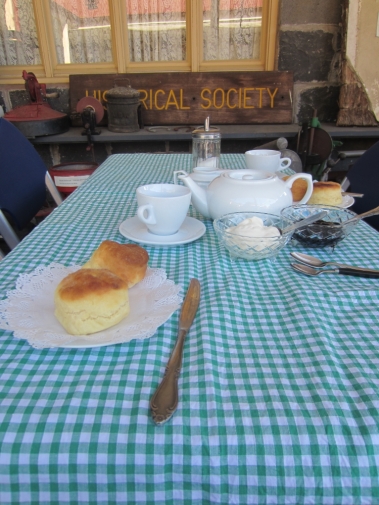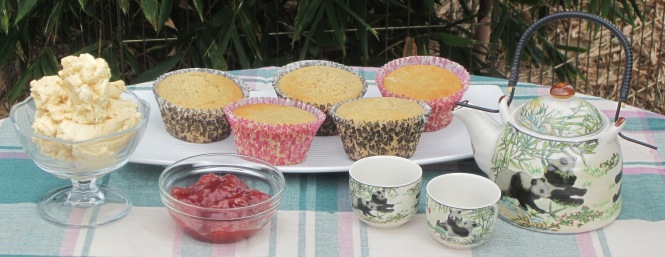What goes on my scones first – the jam or the cream? That is a question many face when confronted by a cream tea. So when the CWA (Country Women’s Association) were offering Devonshire teas (the popular name for cream teas in Australia) I couldn’t resist asking them. Their answer – in Australia – whatever way you like! Free from the burden of choice I decided to try both ways.

My verdict is if you like the jam to be the dominant flavour then put the jam on last, if you like cream to be the dominant flavour then put the cream on last. Either way they are delicious and a great way to spend an afternoon. But how did this battle of the cream teas begin?
While the origins of the cream tea are in dispute, it is generally accepted that a cream tea is a light afternoon snack that is comprised of scones, jam, cream and tea. The scones are cut or broken in half and then spread with jam and cream. Traditionally served in Devon or Cornwall, cream teas are now served worldwide. The confusion about which order to spread your scones has arisen because in Devon you put cream first then jam while in Cornwall you put jam first then cream. They take this issue very seriously so if you visit either county and have a cream tea, make sure you remember which order is “correct” for the county you are in. You don’t want to be thrown out of a tea room without tasting the scones! Now that is clear – problem solved! Not really … Unfortunately the type of scone, jam and cream are also the subject of much debate.
 Scones
Scones
The original Cornish scone was actually a type of yeasted sweet bread roll called a Cornish split.
The scones of today are usually small cakes or quick breads leavened with baking powder rather than yeast.
Scones can be sweet, savoury or filled. Popular fillings are dried fruit or cheese.
There are different types of scones such as potato scones, drop scones, griddle scones and lemonade scones. American biscuits are similar to British scones. Some scones, such as griddle scones, are fried.
For a cream tea the scone should be plain, unglazed, baked and served warm.
Jam
Strawberry jam is traditional but as long as the jam is well made there doesn’t appear to be much angst over using other fruits.
Cream
Clotted cream is best but as it is difficult to get outside of Britain, whipped cream is a suitable substitute. Canned cream is totally unacceptable!
Tea
There doesn’t seem to be much debate on the tea issue. It should be black, very strong with a splash of milk and there should be plenty of it! Green or herbal teas are not acceptable substitutes. Sadly neither is coffee, as the name suggests 😦
So how do I enjoy my cream teas? In true Cornish style with butter first – that’s right butter first, then jam, then cream. Butter was part of the original Cornish cream tea. My experience in Australia is that you are served jam and cream or butter if you prefer, but never both. I save my butter indulgence for cream teas at home. My tea of choice is Earl Grey with a dash of milk.
If you’re a fan of cream teas I’d love to know what you do at home and what you are served when you go out.
And now from the traditional to a very untraditional cream tea – A Panda Afternoon Tea!!
The recipe below is from the (coming soon) cookbook – The Panda Chronicles Cuppycake Cookbook: Favourite Recipes of the Panda Kindergarten. The cookbook is a collaboration between me and artist Anne Belov, creator of The Panda Chronicles. Each cuppycake recipe will have a cartoon and an original painting by Anne. Want to know more about The Panda Chronicles? Just click here to visit Anne, her pandas and Mehitabel the Cat!
Please enjoy this “taste” from the Panda Kindergarten 🙂

Bob T Panda’s Afternoon Tea Cuppycakes
Bob T Panda reinvents the Afternoon Tea with his Earl Grey cuppycakes served with Earl Grey cream and strawberry jam.
Ingredients
for the Earl Grey cuppycakes
1/4 cup boiling water
1 tablespoon Earl Grey tea leaves
1/2 cup (115g) unsalted butter, softened
2/3 cup superfine granulated (caster) sugar
2 eggs
1/3 cup milk
1 + 1/4 cups flour, sifted
2 + 1/2 teaspoons baking powder
for the Earl Grey cream
4 tablespoons boiling water
2 tablespoons Earl Grey tea leaves
1 + 1/2 cup double cream
2 tablespoons powdered (icing) sugar
for serving
strawberry jam
cups of tea
Instructions
Preheat the oven to 180C / 350F.
Line a 12-hole muffin pan with 10 paper cases.
Pour the boiling water over the tea leaves and allow to steep for five minutes.
In a medium sized bowl, cream the butter and sugar with an electric mixer until creamy. Add the eggs one at a time and beat until light and fluffy.
Strain the tea into the batter then add the milk and flour. Beat for 2 minutes or until the batter is light and fluffy.
Using an ice-cream scoop, spoon the batter evenly into paper cases.
Bake for 10 – 20 minutes or until a toothpick inserted into the centre of a cuppycake comes out clean. Allow to cool for 5 minutes before transferring to a wire rack to cool completely.
Make the cream by pouring the boiling water over the tea leaves and allow to steep for five minutes.
Whip together the cream and powdered sugar with a wire whisk until combined. Add the strained tea and beat until fluffy.
Serve with lots of jam and tea.

What a wonderful story and recipes to wake up to this morning! Scones are a controversial topic to natives of Bob T. Panda’s adopted forest. However, these will please every one I know. Party at Candy’s place; as soon as spring weather arrives! Thank you vsomethingspeaks.
LikeLiked by 2 people
Thanks Candy. I’m thinking of experimenting with scones, jam and cream over the next few months. Autumn is coming so warm baked goods and hot beverages will be perfect.
I love the sound of a Spring party at your place!
LikeLiked by 2 people
Oh, this is so cruel…pictures of scones and cuppycakes, and none to be had in the house. I will have to make these cuppycakes! Do you have a recipe for the yeasted scones? that would be wonderful to try, as well as any other favorite scone recipes you may have in your bag of tricks.
I was unaware of the jam over cream or cream over jam controversy. I will certainly experiment with both if I am ever in the neighborhood of clotted cream.
LikeLiked by 2 people
Hi Woozle 🙂
I’ll be experimenting with different types of scones, jams and even attempting to make clotted cream over the next few months. I’ll definitely be posting my adventures. I do have a recipe for Champagne Scones – a variation of Lemonade Scones – in my other cookbook. I’ll be making them again so I’ll a post the recipe when I do.
I haven’t made Cornish Splits – yet! Here is a link to a blog that has a recipe for Cornish Splits and a fabulous variant called Thunder and Lightning which replaces the jam with golden syrup, honey or treacle (molasses!) I serve my Champagne Scones with maple syrup and butter for a Canadian twist. You could try maple syrup with the Cornish Splits too. I know I’ll definitely be trying all the variations 🙂
LikeLiked by 2 people
Reblogged this on Catching Woozles and commented:
There is nothing better than scones and clotted cream, unless it is scones, clotted cream, and cuppycakes.
LikeLiked by 3 people
Thanks for the reblog 🙂
LikeLiked by 2 people
Very informative article on The battle of the cream tea. I would love to know what is clotted cream and is it easy to make? Once again I have to congratulate you on some gorgeous photos the Panda teapot and cups look stunning.
LikeLiked by 3 people
Hi Helen!
The panda tea set is one that I brought back from China. It’s so adorable 🙂
Clotted cream is basically fresh cows milk that is indirectly heated (usually steamed or heated in water baths) and then allowed to slowly cool. The clotted cream rises to the top in lumps and is thick like butter.
At home you can gently heat cream on the stove top or in the oven and then allow to cool. I’ll be making some soon and I’ll let you know how I go.
Leo’s sometimes has it – especially at xmas time. Some of the dairies like Yarra Valley stock it occasionally too.
LikeLiked by 1 person
I think I’d like them either way, as long as there was plenty of jam and cream!
LikeLiked by 1 person
Exactly! You can never have too much jam and cream on a scone 🙂
LikeLiked by 1 person
Although scones are not really popular here, we recently got a more ‘international’ grocery store opened near me, and I noticed they have scones, jam and cream! I will be eating more of them 🙂
LikeLiked by 1 person
I think American biscuits are similar to scones. We call cookies biscuits in Australia so we were very confused when heard of biscuits being served with gravy 🙂 Let me know if you try those “international” scones!
LikeLiked by 1 person
I think England calls cookies biscuits, too. Very confusing! But I think scones may be a little sweeter than our biscuits. Yes, I will have to try some!
LikeLiked by 1 person
I had an American biscuit in Maine and it wasn’t sweet. It was served with butter which I loved.
Yes, England calls cookies biscuits like us. Another confusing difference is jelly. For us, jelly is what you call jello and jam is what you call jelly. When we heard about Americans having peanut butter and jelly sandwiches we were wondering how you could get jello into a sandwich and why!
LikeLiked by 1 person
That is funny! I never knew about jello being called jelly! What we call jelly and jam are slightly different — jelly is a thinner spread with no pieces of fruit in it, and jam is thick with pieces of fruit, seeds, etc. I think jam is definitely better! Jam is also called ‘preserves’ which I think means the fruit is preserved. So interesting about all these words!
LikeLiked by 1 person
Wow – I always thought jam and jelly were the same thing but they aren’t. We also have preserves and marmalade which is one of my favourites because I love citrus peel. Next time I go down the spreads aisle in the supermarket I’m going to have a really good look at what is on offer and what it is. I may even write a blog about it 🙂
LikeLiked by 1 person
That is a great idea! We have marmalade here, but I’ve always thought of it as a ‘foreign’ thing. I love it, though. You have “vegemite” I think? That is one thing I could never get used to!
LikeLiked by 1 person
Lol – marmalade is very British 🙂 I love vegemite. The best way to have it is on toast with lots of butter and a small amount of vegemite. It’s also good as a flavouring in stocks, sauces and stews. But I understand why people loathe it – it is an acquired taste!
LikeLiked by 1 person
Vegemite is one thing that might take me a while to acquire, haha! But I took to marmalade right away! 🙂
LikeLiked by 1 person